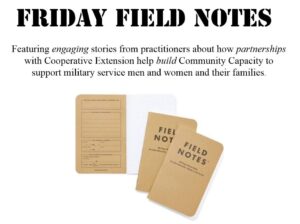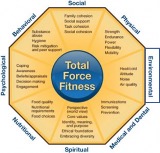
Think back to our series on Total Force Fitness (TFF), specifically the environmental domain…. What do you remember most? Was your overall lasting impression of the environmental aspects of TFF positive or negative? Was it something to be avoided? Embraced?
In the context of military service members who are defending our land, being able to survive in harsh environments with various stressors is an invaluable skill. But what about the rest of us, including family members of service members and civilians? If you look at the environmental domain (pictured below) of TFF, you’ll see that this domain mentions qualities of the environment that should be avoided or tolerated for survival. Instead, we want to look at interactions with the environment that are positive, like those promoted in Outdoor Rx, and how the environment can be embraced in our everyday lives.
Assets v. Deficits
A recent article by HUFFPOST highlights ways that involvement in your local environment is beneficial for urbanites and outdoor types of people alike. The author cites a recent study by the European Centre for Environmental and Human Health at the University of Exeter which found that individuals who spend time in nature are more likely to also engage in other environmentally friendly behaviors, like recycling and using greener forms of transportation. This research shows that there is a mutually beneficial relationship between humans and the environment. When we spend time in nature we benefit from positive physical and mental health outcomes, and we are also more likely to protect the environment from climate change.

Though TFF points out that the environment can be a harsh place especially for service members, it is not something that we always need protection from. In fact, the environment itself needs protection. Initiatives like Outdoor Rx and Park Rx are in the business of promoting such positive interactions with the environment that are mutually beneficial.
Who Has A Relationship with the Environment?
In a perfect world, we would all live near beautiful green spaces where we could meet up with friends to go hiking, stroll through parks, or casually read a book on a park bench. Unfortunately, that is not the case for many Americans. In fact, your ethnicity can play a major role in influencing your interactions with the environment. The HUFFPOST reports that predominantly white neighborhoods have 11 times more green space than that of neighborhoods where 40% of the residents are ethnic minorities. Furthermore, individuals who most commonly use green space are:
- 74% Caucasian
- 10% Hispanic
- 8% African American
- 6% Asian
These disparities are multifactorial. Individuals are less likely to utilize green space when they live in neighborhoods with historical injustice, when the inner-city transits do not travel through natural green spaces, or when they live in violent neighborhoods.
An Environment for Everyone
As Maslow taught with the hierarchy of needs, basic needs must be met before higher order needs can be met. That’s why starting small with the environment can be beneficial for individuals who cannot safely or efficiently access green spaces. If it is not safe for you and your family to access the closest park, then by all means prioritize physical safety. The HUFFPOST suggests barbecuing in your backyard with family or friends. Yes! That counts as time in nature! Easy, huh? Then look for ways to increase sustainability around your home through recycling or using more environmentally friendly serve ware at your barbecue. Small changes can lead to a huge difference!

Maslow’s Hierarchy of Needs
For military families, the personal environment can be quite diverse. Whether on- or off-base, looking for big and small ways to engage the family in nature can ease the transitions that are a part of military life and increase connectedness with community.
Additional Resources
If you are interested in ways that you can become more involved with your environment, or for more information, visit these resources:
How Much Nature Is Enough? 120 Minutes a Week, Doctors Say (nytimes.com)
Connectedness to Nature: Its Impact on Sustainable Behaviors and Happiness in Children (PDF)















